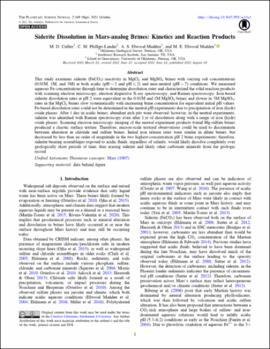| dc.contributor.author | Cullen, M. D. | |
| dc.contributor.author | Phillips-Lander, C. M. | |
| dc.contributor.author | Elwood Madden, A. S. | |
| dc.contributor.author | Elwood Madden, M. E. | |
| dc.date.accessioned | 2021-11-22T19:04:07Z | |
| dc.date.available | 2021-11-22T19:04:07Z | |
| dc.date.issued | 2021-08-24 | |
| dc.identifier.citation | Cullen, M. Elwood Madden A.S., Phillips-Lander, C.M., and Elwood Madden, M.E. (2021) Siderite Dissolution in Mars-Analog Brines: Kinetics and Reaction Products. Planetary Science Journal, 2(5), p. 169 https://doi.org/10.3847/PSJ/ac13a3 | en_US |
| dc.identifier.uri | https://hdl.handle.net/11244/331271 | |
| dc.description.abstract | This study examines siderite (FeCO3) reactivity in MgCl2 and MgSO4 brines with varying salt concentrations (0.01M, 1M, and 3M) at both acidic (pH ∼ 2 and pH ≤ 2) and near-neutral (pH ∼ 7) conditions. We measured aqueous Fe concentrations through time to determine dissolution rates and characterized the solid reaction products with scanning electron microscopy, electron dispersive X-ray spectroscopy, and Raman spectroscopy. Iron-based siderite dissolution rates at pH 2 were equivalent in the 0.01M and 1M MgSO4 brines and slower in 3M MgSO4; rates in the MgCl2 brines slow systematically with increasing brine concentration for equivalent initial pH values. Fe-based dissolution rates could not be determined in the neutral pH experiments due to precipitation of iron (hydr)oxide phases. After 1 day in acidic brines, abundant etch pits were observed; however, in the neutral experiments, siderite was identified with Raman spectroscopy even after 1 yr of dissolution along with a range of iron (hydr)oxide phases. Scanning electron microscopy imaging of the neutral experiment products found Mg-sulfate brines produced a chaotic surface texture. Therefore, micron-scale textural observations could be used to discriminate between alteration in chloride and sulfate brines. Initial iron release rates were similar in dilute brines, but decreased by less than an order of magnitude in the two highest-concentration pH 2 brine experiments; therefore, siderite-bearing assemblages exposed to acidic fluids, regardless of salinity, would likely dissolve completely over geologically short periods of time, thus erasing siderite and likely other carbonate minerals from the geologic record. | en_US |
| dc.description.sponsorship | Funding was provided by NASA grant #NNX13AG75G and the School of Geosciences at the University of Oklahoma. | en_US |
| dc.language | en_US | en_US |
| dc.rights | Attribution 4.0 International | * |
| dc.rights.uri | https://creativecommons.org/licenses/by/4.0/ | * |
| dc.subject | Mars | en_US |
| dc.title | Siderite Dissolution in Mars-analog Brines: Kinetics and Reaction Products | en_US |
| dc.type | Article | en_US |
| dc.description.peerreview | Yes | en_US |
| dc.identifier.doi | 10.3847/PSJ/ac13a3 | en_US |
| ou.group | Mewbourne College of Earth and Energy::School of Geosciences | en_US |

